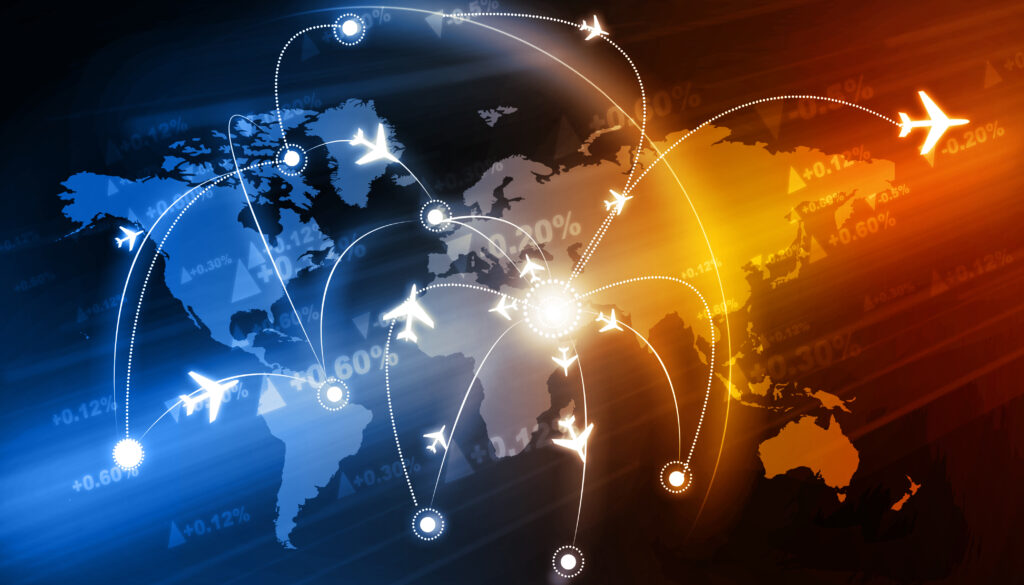- Introduction: The Power of Transport in Tourism
- Transport: the lifeblood of global tourism growth
- Aviation: the wings of global travel
- Low-cost carriers: making travel more accessible
- High-speed rail: the future of land connectivity
- Cruise tourism: setting sail for a new connections
- Building the future: investing in transport infrastructure
- The road ahead: a more connected future
- 5 Key Takeaways
Introduction: The Power of Transport in Tourism
Picture this: You wake up in Dubai, have breakfast in London, and dinner in New York—all in a single day. This isn’t just a luxury for the jet-set elite; it’s a reality made possible by the seamless connectivity of modern transport. Travel today isn’t just about getting from point A to B, but opening up the world, breaking down barriers, and bringing people, cultures, and economies closer together.
Transport: the lifeblood of global tourism growth
Think about your most unforgettable trip. Whether it was a beach getaway in the Maldives, a cultural escape in Kyoto, or an adventure in Patagonia, transport infrastructure was the invisible force that made it happen. Airports, airlines, cruise terminals, highways, and rail networks are the arteries of global tourism connectivity, pumping life into economies and communities. Without transport, travel would not be possible on a large scale.
Transport links create a ripple effect: they enhance accessibility, increase visitor numbers, generate jobs, and boost local businesses. The better the infrastructure and connectivity it provides, the more a destination thrives. In fact, destinations with improved transport connections can see a 30% increase in tourism, according to the World Travel & Tourism Council.Modern transport’s growth and connectivity impact will take centre stage at Arabian Travel Market 2025, which explores the theme ‘Global Travel: Developing Tomorrow’s Tourism Through Enhanced Connectivity’. Conference sessions will delve into a range of topics, from regional investment in transport infrastructure and trends fast-tracking developments, to AI-powered logistics, the rise of the cruise industry, and Sustainable Aviation Fuel (SAF) adoption, all powering improved mobility for the future.
The mantra for enhancing tourism connectivity in the future is ‘Build it and they will come’ as improved transport infrastructure directly influences the growth and success of tourism worldwide.
Aviation: the wings of global travel
There’s no denying that air travel is the major force fuelling tourism growth. Since the 1944 Chicago Convention, international aviation has expanded exponentially, with passenger numbers surpassing 5 billion in 2024 (Air Transport Action Group/ATAG). Today, 58% of all international tourists travel by air, and aviation contributes a staggering $4.1 trillion to the global economy. Destinations with strong aviation connectivity see a notable increase in tourism growth, as seen in Lisbon, Portugal, where a 20% surge in visitors followed airport expansions.
Dubai stands out as a leader in air connectivity. In 2023, aviation accounted for 27% of the city’s GDP ($37.3 billion), a figure expected to climb to nearly one-third by 2030. More than 1,356 new air routes launched globally in 2024, with low-cost carriers (LCCs) playing a crucial role in tourism connectivity by opening new markets and making travel more accessible. Globally, new air routes are constantly opening, unlocking hidden gems for travellers. In 2024, more than 1,356 new air routes were launched in just Europe, with low-cost carriers (LCCs) playing a crucial role in facilitating tourism connectivity.
Low-cost carriers: making travel more accessible
Responsible for operating one-third of all airline seats globally, low-cost carriers have turned travel from a privilege into an everyday possibility. These budget airlines have changed the game by making flights more affordable, enabling spontaneous trips, and expanding access to destinations that were once off-limits.
Kuala Lumpur Airport is one hub pivotal to fuelling this tourism connectivity. Offering 14,583 possible low-cost connections to 137 destinations, it emerged as the world’s top low-cost carrier hub in 2024, reveals OAG Megahubs 2024.
While Asian hubs dominate these rankings, Dubai International Airport (DXB) is the largest Middle East contributor, ranked 7th globally, playing a central role in budget travel to and from the region. Riyadh (RUH) is also named one of the Top 25 Low-Cost Carrier Megahubs, reflecting Saudi Arabia’s growing aviation ambitions. New LCC routes represent more than just increased seat availability—they offer travellers access to secondary cities and lesser-known destinations, boosting local economies and dispersing tourism away from overcrowded hubs, not to mention reuniting friends and family.
High-speed rail: the future of land connectivity
While LCCs have revolutionised regional travel, a cheaper and greener alternative – high-speed rail –
Is gaining traction. In 2025, railway travel dominates global travel trends and to facilitate this, major development projects are underway in Asia, Europe, and the Middle East, boosting tourism connectivity. They include the California high-speed rail, connecting major cities like San Francisco, Los Angeles and San Diego; the Grand Paris Express, improving urban mobility in the Greater Paris region; the Jakarta to Bandung high-speed rail in Indonesia, dramatically cutting travel times; and the 500-km Mumbai to Ahmedabad service, bolstering economic development along the way.
The UAE’s ambitions for rail include the hyperloop railway project, connecting Abu Dhabi and Al Ain in just 10 minutes, and a new high-speed train service linking Abu Dhabi and Dubai, recently announcedby Etihad Rail. In tune with the UAE’s vision to be a global leader in smart transportation, the latter will cut travel times to 30 minutes, enhance the quality of life for citizens, residents and visitors, and strengthen socioeconomic ties between the two emirates.
Saudi Arabia has also launched a raft of rail projects that will benefits locals and visitors alike. They include an upgrade to a high-speed service on the Riyadh to Dammam route and a 950km service linking Riyadh to Jeddah on the Red Sea coast.
Both follow in the footsteps of the successful high-speed Haramain Train, connecting the Holy Cities of Makkah and Madinah, with a branch to King Abdulaziz International Airport in Jeddah. Transporting thousands of passengers daily, including tourists and pilgrims, it has strengthened Saudi Arabia’s religious tourism sector, making it faster and more convenient for Umrah performers to reach the Grand Mosque and the Prophet’s Mosque.
GCC nations are also joining forces to build a unified railway network, set for completion by 2030. The GCC Railways project will connect Saudi Arabia, the UAE, Bahrain, Qatar, Oman, and Kuwait, presenting exciting opportunities for intra-regional tourism.Rail travel not only saves time, but it’s sustainable travel game-changer too. A train trip can emit up to 96.5% less CO₂ than a flight, with Berlin to Prague a prime example – it’s 30 times more eco-friendly to travel this route by rail than by plane. Rail also encourages travel to less-visited regions as the AVE (Alta Velocidad Española) demonstrates, boosting tourism in cities like Toledo and Córdoba and enabling travellers to visit multiple destinations in a single day.
Cruise tourism: setting sail for a new connections
Beyond land and air, the cruise industry continues to expand. A major force for tourism connectivity, it transports travellers to multiple destinations and experiences in one hit while delivering economic benefits to every port of call.
In 2023, the cruise industry generated $168.6 billion in global economic impact—a 9% increase over 2019—along with 1.6 million jobs and $56.9 billion in wages, according to Cruise Lines International Association (CLIA). Notably, 77% of these jobs were land-based, highlighting the industry’s broader impact. Cruise also contributed $85.6 billion to global GDP, outpacing overall economic growth. Consumer demand for cruise continues to grow at pace, with global cruise passenger volume hitting the 31.7 million mark in 2023—7% higher than pre-pandemic levels. By 2027, that number is expected to reach nearly 40 million.
Global cruise capacity is accelerating in tandem, reaching 677,000 cruise ship berths in 2024 and set to grow 10% to total 745,000 by 2028. There is more than enough growth potential in the market to fill these berths, because:
- More than 12% of cruise travellers cruise twice a year
- 10% take three to five cruises annually
- 82% of those who have cruised will cruise again.
- 71% of international travellers are considering taking their first cruise.
Cruise tourism is expanding beyond mega ships, with expedition cruising fast on the rise. These small, eco-conscious ships connect travellers to remote destinations like the Arctic, Antarctica, and the Pacific islands. Passenger numbers for these itineraries have surged by 71% from 2019 to 2023, making it the fastest-growing cruise segment (CLIA).
Water travel is also evolving, with Candela leading the way. The Swedish marine tech company is transforming transport with electric hydrofoil vessels that glide above the water, reducing energy consumption, noise, and environmental impact. Candela’s zero-emissions ferries cut energy use by up to 80%, offer a smoother ride, and have recently launched the world’s first electric foiling ferry in Stockholm. With plans to expand to Saudi Arabia’s NEOM and cities across Europe and the US, Candela is already popular in Dubai, providing sustainable travel options for luxury travellers.
Building the future: investing in transport infrastructure
Of course, no mobility solution is possible without transport infrastructure investments. Globally, infrastructure spending is set to surge, with annual investment projected to exceed $9 trillion this year (2025) according to PWC. Asia-Pacific leads the way, driven by China, which allocated $173 billion to transport projects last year alone ((businesswire.com). The OECD notes that China, New Zealand, and Türkiye top the ranking for airport investment relative to GDP, positioning them as key global aviation hubs.
Meanwhile, London Heathrow Airport’s long-awaited expansion is finally moving forward, with a proposed third runway increasing passenger capacity from 80 million to 140 million per year, generating 100,000 new jobs and boosting the UK’s role as a global travel hub.
Dubai Airports is upping its game too. Already known for its DXB mega hub, which welcomed a record 92.3 million passengers in 2024 as world’s busiest international airport for the 11th consecutive year (ACI), it is now undertaking one of the world’s most ambitious infrastructure projects—the $35 billion expansion of Dubai World Central – Al Maktoum International. Once complete, it will become the world’s largest airport, handling 260 million passengers annually and reinforcing Dubai’s status as the most connected city on the planet.
Dubai is also ploughing funds into cruise infrastructure, investing heavily in state-of-the-art cruise terminals and enhancing port facilities to streamline arrivals and departures. Its Mina Rashid terminal, one of the most advanced in the region, continues to welcome an increasing number of international cruise lines, solidifying Dubai’s position as a global cruise hub, with the destination receiving more than 281,000 cruise passengers on 187 ships in the first 11 months of 2024.
Saudi Arabia is making waves too, led by Cruise Saudi, a government-backed initiative designed to transform the kingdom into a premier cruise destination. With a vision to welcome 1.3 million cruise passengers annually by 2035, Saudi Arabia is investing in new ports, enhanced shore experiences, and strategic partnerships with global cruise operators, as well as its own cruise line, AROYA. The development of key destinations such as Jeddah, Yanbu, and NEOM’s Sindalah Island is central to this growth, offering travellers unique cultural and natural experiences along the Red Sea. These transport infrastructure developments are more than capacity building exercises; they are future-proofing the growth of the tourism industry. New airports, rail links and cruise facilities are creating endless possibilities for mobility and connectivity.
The road ahead: a more connected future
The future of travel is faster, more accessible, and increasingly sustainable. As transport networks continue to evolve, new opportunities for tourism, business, and cultural exchange will emerge.
Ultimately, advanced transportation not only moves people to places—it fosters human connection, breaks down barriers, and drives socioeconomic progress. Because in the end, is not just about the destinations we visit, but how we get there too.
5 Key Takeaways
1. Transport infrastructure is essential to global tourism growth, facilitating accessibility, economic development, and sustainability.
2. Aviation remains the backbone of tourism connectivity, with new air routes driving expansion and economic impact, creating jobs and prosperity.
3. Low-cost carriers and high-speed rail are transforming tourism accessibility, making travel more affordable and environmentally friendly and opening up lesser-known destinations to mitigate overtourism.
4. Cruise tourism is evolving is connecting people to more places, with the industry showing high growth potential and expedition cruising and eco-friendly water transport leading new travel trends.5. Investment in transport infrastructure is critical to supporting the future of tourism, with major projects in aviation, rail, and maritime sectors driving growth and boosting global connectivity for tourism and trade.






